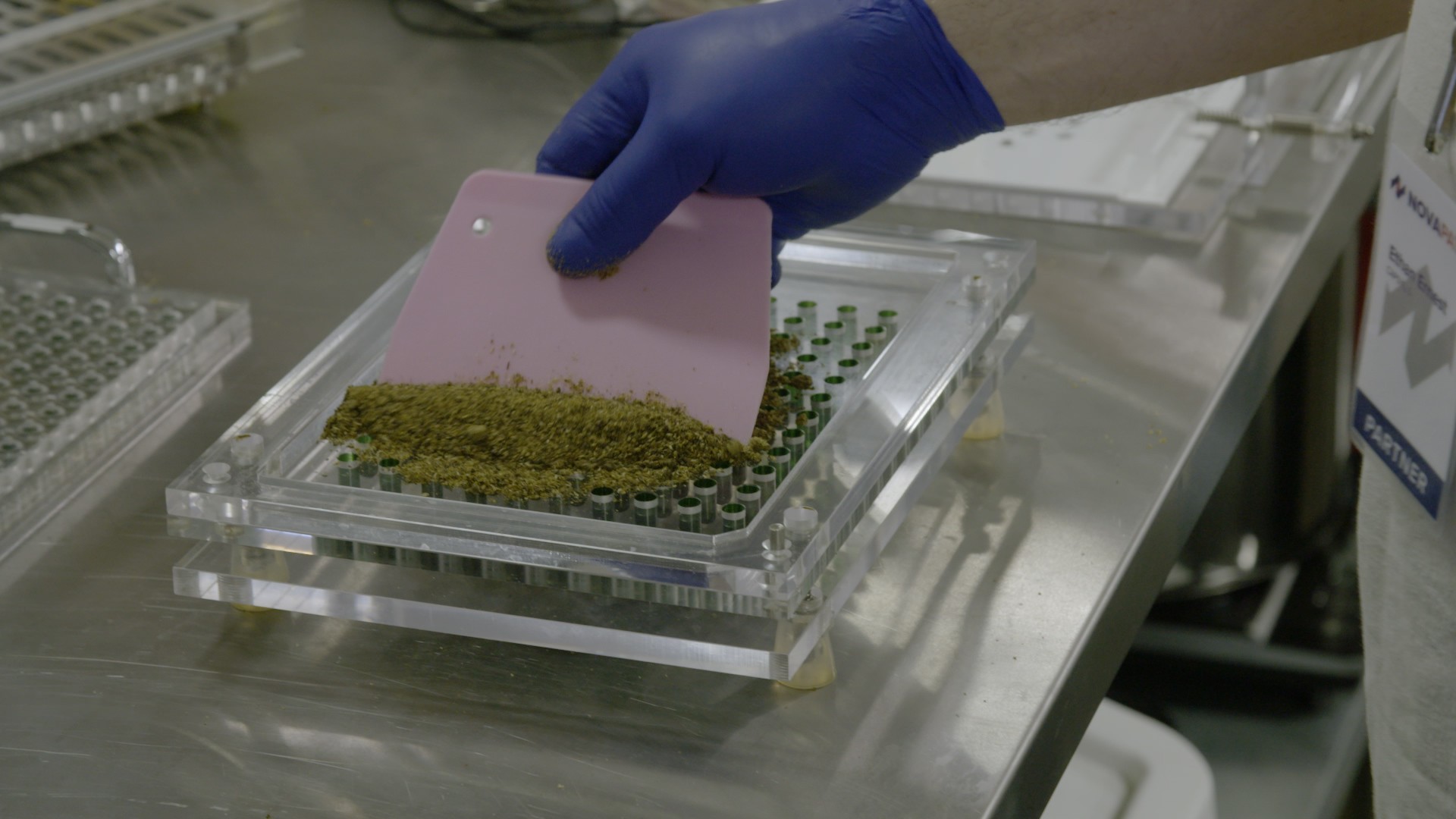Photo illustration by Elizabeth Renstrom, Kitron Neuschatz, and Lia Kantrowitz
For Debbie Anderson, it starts with a feeling of pressure behind her right eye. The pulsing sensation then fans out behind her forehead. Soon, her cranium is ablaze with pain. “It’s like my brain is trying to escape my skull,” Anderson says. She sometimes vomits from the pain.Anderson, 49, has suffered from migraines for two decades. She works from home as a freelance writer, partially so she can manage the attacks whenever they come. For years, she has gone to an emergency room every few months. The routine had been mostly consistent: The doctors gave her painkillers and she kept a few for the next migraine.About six years ago, ER doctors became more rigid about sending patients home with the meds, which were opioids, she says. Anderson then began smoking cannabis for relief. “It worked very similarly to Percocet except not as overpowering,” she says. “It doesn’t make you feel zombie-like like Percocet. It takes the pain away.”New Jersey, the state in which Anderson resides, began a legal medical marijuana program in 2010. Soon after, Gov. Chris Christie took office with a harsh view against pot. The program remained, but it was small and restrictive during his term. Migraines was not one of the conditions it covered, so Anderson spends about $60 a month on weed from a dealer. “I feel like I’m more productive now,” she says. “There’s a feeling of safety in having access to marijuana.”Yes, but it's limited. Cannabis has a history as a headache remedy going back a few millennia. Manuscripts from the Mesopotamia region dating to the second millennium BCE, for instance, advise the use of cannabis to “bind the temples,” according a survey of history and scientific study of marijuana use for headache relief compiled by the Center for Medicinal Cannabis Research at the University of California, San Diego. Physicians from ancient Greece and the Middle Ages of Europe also kept weed in their arsenal of cranial pain therapies. Many prominent pioneers of modern neurology wrote of its benefits in the late 19th and early 20th centuries. Once social perceptions changed during the “Reefer Madness” era of the late 1930s, its clinical use declined.Because the US Controlled Substances Act of 1970 labeled it a schedule 1 drug, with supposedly high potential for abuse and no medical value, it was mostly shut out of modern medical research. Physicians have an incomplete understanding of how marijuana helps people with migraines, but emerging scientific evidence—and the testimonies of black-market users—suggest that it does. For patients with chronic pain, cannabis might also be a suitable alternative to the increasingly deadly and problematic use of opioid painkillers.“We don’t have a lot of data on how well it treats headaches,” says Igor Grant, director of the Center for Medicinal Cannabis Research. “We do have enough evidence to think it is worth investigating further.”
More from VICE:
While the causes of headaches and migraines are not yet fully understood, irregularities in serotonin and other neurotransmitters may play a role, as might interactions between nerves and the brainstem. The endocannabinoid system, the brain’s network of reception sites for the active chemical compounds in cannabis, tends to act as a “circuit breaker” for the brain, Grant says. “If some system is overactive, the endocannabinoid system tends to quiet it down. Even in cases when the brain seems to be depressed, it’s a stabilizing system.” (The endocannabinoid system was first outlined at Hebrew University in Israel, a country that acts as a unique outpost for advanced medical marijuana research.)Some migraines may also be caused by inflammation, particularly among female patients, and THC is thought to be an immunosuppressant. The first clinical trial to demonstrate the effectiveness of marijuana in treating migraines was conducted at University of Colorado’s Department of Clinical Pharmacy and published in 2016. A group of 121 adults used medical marijuana to treat migraine headaches. Frequency decreased from 10.4 to 4.6 headaches per month among the group, and about 40 percent reported fewer migraines—or the prevention of them—through smoking. The study left many questions open, like the best strains and right dosages, suggesting those for further research.There is recent evidence that people with chronic pain decrease their opioid usage once marijuana is legalized in their state. A University of Georgia study, released this month, found a nine percent reduction in the filling of opioid prescriptions among Medicare Part D recipients in states post-legalization. Joseph Rosado, a medical consultant to International Cannabis Solutions, a Toronto-based consulting firm, and a general practitioner in Orlando, says he often prescribes medical marijuana to migraine patients, particularly ones who want to kick prescription opioids. “It helps them come off the narcotics,” he says.Rosado’s regimen varies, he says, but he typically prescribes 0.1 milligrams of sativa for each pound of the patient’s body weight, taken daily, if they use a vaporizer or typical inhalation method. For an edible oil or capsule, his usual recommendation is 30 to 35 milligrams per pound.Due to the lack of medical marijuana programs or their restrictiveness in some states, many patients who use cannabis for migraines do so without medical consultation, free-balling their dosages and usage frequency. Claudia Williams*, a graphic designer in Philadelphia who “smoke[s] a couple times a day” to mitigate her chronic migraines, says her doctor and chiropractor are aware of her habit. She says they “are tolerant” of it, but she’s had to figure out her regimen.She spends $300 a month on weed and uses several times a day. “A slightly baked me is a high-functioning me,” she says, adding that she earned a master of business administration and increased her income as a freelance designer while perpetually low-level-stoned to fight off migraines. Her “delivery service” comes by almost daily. “If I don’t call, he gets concerned,” she says.Williams has experienced migraines since her early teens, which she attributes to childhood injuries. “I took a dive off a bunkbed, with a poor understanding of gymnastics, and also I fell off a horse,” she says. She displaced a disc in her spine, causing a pattern of what she describes as inflammation that created a floodgate of pain into her head. She started smoking cannabis for her condition in her late 20s.Williams credits Philadelphia’s decriminalization measures for making it easier. In 2014, the city removed criminal penalties for possession of less than 30 grams of marijuana. She’s mindful to never keep more than that in her home (hence the frequent deliveries). But if a city cop catches her with a modest amount, she’ll only face a fine. Williams carries a vape pen in case of a migraine and has even smoked walking down the street. “It’s pretty low-risk, depending on who you are, what you do and how ballsy you are,” she says.
Anderson hopes political changes in New Jersey will help her go legal. Under Gov. Christie, medical marijuana was prohibitively expensive. Also, it was difficult to find a doctor to prescribe, Anderson says. There was a public registry of prescribers. “A lot of doctors did not want to be on it before of the stigma or fear they’d get a call from everyone who wanted it,” she says. As of 2018, just 536 physicians are registered in a state with 28,000 doctors.Democrat Phil Murphy assumed the governor’s office in January and ran on a platform of legalizing weed. Last month, Murphy expanded the conditions making one eligible for a medical marijuana prescription to include chronic pain, anxiety and migraines. He also eliminated the public registry. There will, of course, be even greater access if the state fully legalizes.Still, Anderson worries. “I have good insurance," she says, "and it doesn’t cover medical marijuana."Also, she has had to fight a perception that she never thought she’d face as a middle-class, middle-aged, college-educated professional: the constant perception that she’s faking her condition just to get high. She’s gotten dirty looks and extensive questioning at the ER, after the backlash against opioid usage. She is considering seeking a marijuana-prescribing doctor and even saved up the $500 that some medical clinics charge for entry into the program. She’s worried she’ll be scrutinized and reduced to a mere pothead looking for a connection. “It’s dehumanizing and humiliating,” she says.Anderson adds that, before using it to treat migraines, she had not smoked cannabis since her 20s, and she didn’t care for the effects. “I didn’t see myself using marijuana again,” she says, “I really didn’t see myself smoking daily, but that’s what’s been working.”*Name changedSign up for our newsletter to get the best of Tonic delivered to your inbox weekly.
Advertisement
Is there evidence for weed as a headache treatment?
Advertisement
More from VICE:

How exactly does weed help with headaches?
Advertisement
How much weed should you use if you're treating a headache?
Advertisement
Advertisement
